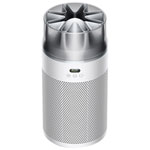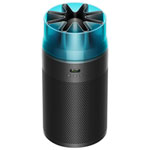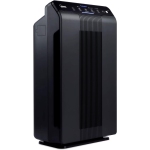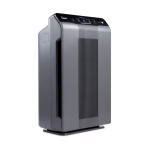Air purifier & Air Filters
Nothing is more important than the air you breathe. You can go days without food or water, but only minutes without oxygen. And the quality of the air that you breathe is equally important, as it affects your health and overall well-being. Air purifiers are devices for your home that can remove harmful contaminants from the air in a room, cleaning and freshening what you and your family breathe every day. These devices come in different types and with a variety of features. Here’s what you need to know.
What is an air purifier and how do they work?
An air purifier is a small appliance for the home or office that uses a fan and internal filter to pull in unwanted particles from the air, like viruses, bacteria, dust, dander, smoke, mould spores, and other allergens. The microscopic particles are captured in a filter that you clean or, most likely, replace as needed. It then circulates purified air back into the room.
The best air purifiers, from brands like Dyson and Honeywell, include multiple filters, most notably a Air Purifier with HEPA (High Efficiency Particulate Air) filter that can capture 99.97% of airborne particles. This is usually alongside a carbon filter that uses activated carbon (charcoal) to remove gases and volatile organic compounds (VOCs) from the air, which are released from common household products. Other newer types of filters include particle filters and formaldehyde filters.
Improving air quality in your space is beneficial to your overall respiratory health and wellness and can even potentially result in improved sleep. Air purifiers are especially useful if you have pets that produce a lot of dander or family members with allergies or asthma. They also help eliminate odours, contaminants, and harmful gases caused by everything from pungent cooking smells to paint and chemical cleaning products.
The majority of air purifiers consist of a fan (or more than one) and air purifier filters (of which there are a few different types). Most pollutants in your home are suspended particulates (microscopic solid or liquid matter), so an air purifier works at mechanically separating the pollutants by forcing the room’s air through its filters. This is called a passive air purifier. There are also active purifiers, which use ionization to clean the air. Passive air purifiers tend to be more effective, as they permanently remove particulates by trapping and collecting them in the filters (which will need regular cleaning to maintain peak efficiency).
Benefits of using an Air Purifier
Air purifiers (also known as air cleaners) from Dyson, Honeywell, Blueair, Germ Guardian or Bionaire do more than just freshen the air. They can help to reduce or remove a whole host of things from the air, essentially cleaning what you breathe. And, breathing cleaner air helps you sleep better, and can improve your lung function, as well. Here are some examples of what an air cleaner does in your home:
Reduces Allergens
Look at a shaft of sunlight streaming in from the window and you will be able to see the amount of dust floating around in the air. Dust can be a major allergen for some people, not to mention an endless chore to clean up. In addition to dust, our homes contain other allergens, such as pollen, mould spores, and dust mites. If you or someone in your family suffers regularly from allergy symptoms, an air purifier can greatly reduce all these common allergens around your home.
Absorbs Harmful Chemicals
There are a host of harmful chemicals that can be found in your home. From the thousands of chemicals found in second-hand smoke, to formaldehyde that evaporates from paint, these chemicals pose a risk to your health and can have you experiencing “sick building syndrome.” The more advanced air purifiers can eliminate a great number of these chemical, bacterial, virus, and DNA-damaging particulates.
Removes Household Odours
Nobody wants to have a house that smells like stale air, or worse. That’s where an air purifier comes in. Since the air is passing through filters, the purifiers also remove unwanted odours while cleaning the harmful particulates from what you breathe at the same time. So go ahead and cook that fish dinner, because the smell won’t linger as long as you have the right kind of air purifier.
Ideal for Pet Owners
Considering the things an air purifier does in the home, it is a perfect device for pet owners. An air purifier can reduce and remove pet allergens such as dander, while also removing that awful wet dog smell from your living room. Even if you or someone in your family doesn’t suffer from a pet allergy, chances are someone who visits your home does, so having an air purifier can make your household a lot more comfortable and inviting to those particularly pet-sensitive people.
Types of Air Purifier Filters
Now that you know how an air cleaner can improve the quality of life around your home, not to mention your overall health, you need to know about the various types of air purifier filter technology options for home air purifiers.
HEPA
The primary filter tech in air purifiers is called high-efficiency particulate air filters or HEPA. HEPA filters remove at least 99.97% of 0.3-micrometre particles and are usually more effective at removing larger particles.
Carbon Filters
Carbon-based air purifiers use activated carbon, which is a porous material that can absorb and dissolve harmful chemicals (but not larger particulates) by turning them from gas to a solid. Carbon filters are also good for removing household odours. Normally, carbon-based filters are used in conjunction with HEPA filters in air purifiers.
Ionizer Purifiers
These high-tech purifiers use electrical surfaces or needles to generate gas ions, which attach to airborne particles. These charged particles are then attracted to a collector plate in the purifier.
Choosing the Right Air Purifier for Your Home
While budget and personal needs will dictate what kind of air purifier you want (whether it is for reducing allergens, odours or chemicals, etc.), you also need to ensure the device you choose is appropriate for the room or space you want covered. Air purifiers are rated with a coverage area (square feet). Measure your room and buy something that has a higher coverage. For instance, if you have a 200-square-foot room, buy an air purifier that is rated for a 300-square-foot room.
In addition, you may want to look for additional features when choosing an air purifier, such as built-in humidifiers, quiet modes (for nighttime), smartphone or Internet control, remote control, or air quality indicators or displays.
Where to Place Your Air Purifier
Consideration should be made for where you intend to place your air purifier. Proper placement ensures maximum efficiency, so if you place it under a table, right up against a wall, or in between large pieces of furniture, the amount of air it can circulate and clean will be greatly reduced. Make sure to place the purifier out in the open where it can adequately circulate the air in a particular room. Also, keep in mind that air purifiers work best when doors and windows are kept closed.
Discover other appliances such as cooling, heating, or air quality products for all types of rooms at Best Buy.







